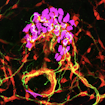
On January 8–9, 2024, SFARI welcomed researchers to its second annual meeting of the SFARI Sex Differences Collaboration (SSDC). Simons Foundation Executive Vice President of Autism and Neuroscience Kelsey Martin and SFARI Senior Scientist Alan Packer greeted the 70 in-person and 56 virtual attendees.
This collaboration seeks to understand the reasons for the male bias in diagnoses of autism spectrum disorders (ASD), which is four times that in females. Understanding how this bias comes about could reveal fundamental mechanisms contributing to ASD, and potentially suggest therapeutic approaches. In 2021, SFARI committed $28 million to five collaborative groups, each of which focuses on different aspects of the question, including genetic, cellular, animal model and human approaches. The projects explore current ideas behind how the sex bias in ASD arises; for example, is it something intrinsically linked to sex chromosomes, or does it represent interactions between ASD risk factors and sexually differentiated ones, be they genetic, hormonal or neural?
The meeting was organized by themes that cut across work in the five different groups, which themselves consist of members from different institutions. Thus, to set the stage, each group director gave a short talk to introduce each group’s approach.
Simon Baron-Cohen of the University of Cambridge introduced the APEX (Autism and Prenatal Sex Differences) group, which is looking for genetic clues to sex differences in autism likelihood by tracking the elevations of sex hormones prenatally in human studies, then combining genetic and hormonal factors systematically in human brain organoids to understand their interactions. Aravinda Chakravarti of New York University leads a team organized around the possibility that the sex ratio in autism reflects sex-biased changes in genes and their regulators, which in turn produce sex differences in brain development. The third group, led by Joseph Dougherty of Washington University, is looking for epistatic interactions between genes and biological sex1, as well as between genes and environment to explain the sex bias in autism; for example, variation at hormone-sensitive genetic elements may contribute to the sex bias.
David Page of the Whitehead Institute and the Massachusetts Institute of Technology introduced the fourth collaborative group, which focuses on molecular explanations for the sex bias observed in autism, and whether microglia mediate this. One hypothesis is that the inactive X and Y chromosomes contribute to sex bias, since they have been found to modulate gene expression. Stephan Sanders of the University of Oxford introduced the fifth group, which hypothesizes that interactions between sexually-dimorphic brain regions and autism-impacted brain regions could either exacerbate or attenuate autism-related behaviors, and thus contribute to the sex bias.
Epidemology
Not only are girls less commonly diagnosed with autism than boys, but their diagnoses come later2, which could indicate that autism arises from processes that differ between boys and girls. Analyzing socio-emotional trait data collected from a UK birth cohort, Varun Warrier of the University of Cambridge has found that, indeed, girls are over-represented in the group that is diagnosed in adolescence — a time when social demands become more complex and might unmask social difficulties in girls for the first time. However, Warrier finds that this is not necessarily sex differences but rather differences in socio-emotional developmental trajectories. Furthermore, genetic data from the SPARK (Simons Foundation Powering Autism Research) ASD cohort shows some evidence for heritability of age of diagnosis; this supports the idea that genetic factors in part drive different development paths to an ASD diagnosis. Caroline Fyfe of the Karolinska Institute also finds an increase in females diagnosed in adolescence as part of an overall increase in ASD prevalence during the past 35 years in Swedish National Register data, which includes 2.75 million children. The male-female ratio decreased as age of diagnosis increased, which might reflect broadened diagnostic criteria applied to older females or different female expression of autistic traits.
Genetics: Variants
Because de novo genetic variation contributes to ASD risk, sex differences in the burden of de novo variants could underlie the sex bias in autism. Indeed, Tychele Turner of Washington University in St. Louis and colleagues have found sex differences in the burden of de novo mutations linked to neurodevelopmental disorders (NDDs), both in X-linked and autosomal genes3. To examine whether this contributes to ASD, Turner is examining additional genome data of over 26,000 families from the SPARK ASD cohort using new analytical tools4, 5. This turns up more sex-biased gene-disrupting de novo variants, on the X chromosome and on an autosome.
Besides carrying different genetic variants, males and females could also show different outcomes to the same ASD genetic risk factors through interactions with other genes, regulatory elements or sex hormones. This has prompted Turner to also look for non-coding de novo mutations in regions important for sex hormone signaling. Din Selmanovic of Washington University is also looking for sex-dependent effects of known ASD genetic risk factors, both common and rare, by introducing genetic variation into cell models using a massively parallel reporter assay (MPRA) to detect enhancers and repressors of gene expression. In vivo, he is exploring the effects of these same variants when injected into mouse brain at a time when estrogen masculinizes the brain.
Genetics: Enhancers
To get a handle on the genetic controls for gene expression that may matter for ASD sex differences, Chakravarti argued that it was necessary to make a reference map for functional non-coding elements (enhancers), which would help shrink down the genome to its functional parts. Chakravarti’s lab has so far identified about 167,000 enhancers in the human fetal cortex and has found sex-biased differences in their activity in approximately 15 percent of those from which sex-biased gene expression could arise. The lab is also looking for sex hormone-related modulation of gene expression, as presented by program manager Hanna Berk-Rauch. Specifically, when estrogen is applied to human cortical neurons derived from induced pluripotent stem cells (iPSCs) in vitro, changes in gene expression are observed after prolonged, but not acute, estrogen exposure.
Several researchers are interested in the role microglia may have in mediating sex-dependent effects of ASD risk; immune system activation is linked to ASD, microglia appear in the brain early in development, and these cells are sensitive to environment cues, like sex hormones. Christopher Glass of the University of California, San Diego and colleagues are comprehensively characterizing human microglial cells, which display profiles of transcription, chromatin accessibility and transcription factor networks that differ with stage of development6. Ongoing experiments are exploring microglia differences between males and females. Tracking variation in enhancer activity between neurons taken from different brain regions may also highlight the parts of the brain that mediate ASD risk, as presented by Olivia Corradin of the Massachusetts Institute of Technology. Although most active enhancer regions look the same across seven brain regions in samples from healthy donors, 7 percent of them differed from region to region. These brain region variable enhancers disproportionately contributed to ASD genetic risk, with frontal cortex specific enhancers having the strongest overall contribution to heritability.
Genetics: Sex chromosomes
When looking for explanations for ASD sex bias, the inactive X and Y chromosomes deserve a closer look. In his lab, Page has found that the expression of 38 percent of genes on the active X chromosome is influenced by the inactive X chromosome (Xi), once thought to be largely inert, through the study of cells from people with X and Y aneuploidies7. This influence even extends to the autosomes, where thousands of genes raise or lower their expression levels in response to changing copy numbers of the inactive X or the Y chromosome8. Since Xi versus Y is the only genetic difference between female and male genomes, this kind of mechanism could give rise to sex-differentiated gene expression relevant to ASD.
Evan Eichler of the University of Washington presented his lab’s findings of X chromosome contributions to the ASD sex bias. Analysis of de novo mutations in over 60,000 people with NDDs reveals genes that carry variants more frequently in one sex versus the other; this amounted to 15 new female-enriched genes and 12 new male-enriched genes. Long-read sequencing of the genomes of females with ASD and their families is giving a nearly complete view of the X chromosome sequence and has detected new, likely pathogenic, variants. In a separate project, Eichler described analysis of methylated regions of the genome in those with ASD and their families. This highlighted hyper-methylation of the maternal X chromosome in females with ASD compared to their control siblings.
Regulation of X-linked genes can offer insights into the ASD sex bias as well as on therapeutic strategies. Huda Zoghbi of Baylor College of Medicine illustrated this through her studies of MECP2, an X-linked gene that exhibits dose sensitivity, with too little resulting in Rett syndrome and too much in MECP2 duplication syndrome. Zoghbi presented evidence for different kinds of genetic modulators of MECP2 levels, including other ASD- or NDD-associated genes that act post-translationally. She is also using MPRAs to dissect the nearby regulatory elements of MECP2 and other X-linked NDD genes, and is taking steps to identify microRNAs and their bindings sites that modulate MeCP2 levels. She hypothesizes that mild mutations to any of these could lead to aberrations in MECP2 levels, and result in ASD in males.
Neurodevelopment: Transcriptomics and epigenomics
Sanders and colleagues have proposed that the ASD sex bias results from an interaction between cells impacted by ASD liability and cells that differ by sex. His team has begun by pinpointing where in the brain ASD-related genes are particularly active. In humans, ASD gene activity is particularly high during the second trimester, and distributed over many regions, including cortex, thalamus, hippocampus and hypothalamus. Emilie Wigdor of the University of Oxford presented a similar approach to identify places in the cortex that differ most between males and females. Wigdor described some sex differences in gene expression and chromatin accessibility found in autosomal and X-linked genes in excitatory neurons of human prefrontal cortex. The group is also looking closely at subcortical regions like the medial amygdala, striatum and bed nucleus of the stria terminalis (BNST), which may show more pronounced sex differences than cortex.
Jonathan Mill of the University of Exeter has also been seeking cell type-specific sex differences in the brain through epigenomic and transcriptional studies, including analysis of the many novel transcripts that are turning up with long-read sequencing. Mill has found sex differences in DNA methylation patterns that vary by cell type and developmental stage. In ASD brain tissue samples, differences in DNA methylation were particularly pronounced in microglia, and even more so between males and females. This could result in sex-differentiated gene expression patterns, which may lay groundwork for an autism sex bias.
Because sex differences in the brain could arise prenatally, Tomasz Nowakowski of the University of California, San Francisco and his lab have been comprehensively characterizing human fetal cortex samples from the second trimester to identify which genes are differentially expressed and in which cell types. His student, Kelsey Hennick, described her work finding differential gene expression between male and female prenatal brain samples in multiple cell types, including microglia. She also finds some overlap between DNA binding sites for androgen and estrogen receptors and ASD risk genes that show sex-differential expression. This suggests some ASD-related genetic variation may modulate a cell’s response to sex hormones.
Neurodevelopment: Sex hormones
Sex-specific patterns of sex hormone release in the prenatal brain can alter neurodevelopment8, and potentially autism likelihood. In his talk, José González-Martínez of Madeline Lancaster’s lab at the Medical Research Council presented his rationale and plan to track sex hormone effects in human brain organoids engineered to carry autism-related mutations through CRISPR editing. Similarly, Deepak Srivastava of King’s College London presented work to characterize the effects of estrogen on neurodevelopment in human brain organoids. Estrogen receptors are detectable in these organoids in several ways, and through experiments to find optimal estrogen concentration and timing, Srivastava has also found estrogen-induced changes in gene expression.
Moderated discussion: Biological effects of sex hormones
In vitro models offer a powerful way to tease apart contributions from sex-specific hormone surges from sex-differentiated genetics. A moderated discussion provided an opportunity to grapple with technical issues related to these model systems and their uses in approaching the ASD bias question. Alex Tsompanidis of the University of Cambridge outlined the complexity of sex hormone action in a fetus, with interactions between the fetus, placenta and mother. Moderator Deep Adhya of the University of Cambridge guided the discussion, which touched on the optimal dose of and exposure time to sex hormones, localization of sex hormone receptors in prenatal brain cells, the need for isogenic control lines to aid interpretation, the usefulness of reporter molecules that can give a readout of when hormone receptor regulatory elements are active, the interpretative difficulties presented by sparse sex hormone receptor expression, the value of non-human primate models, and the need for a common library of cell lines that can be used across different labs to improve replicability.
Neural circuits and glia
In her talk, Nicole Coufal of the University of California, San Diego showed evidence of sex chromosome contributions to human microglia development and function. In microglia derived from patients with Y chromosome aneuploidies, she finds dose-sensitive decreases in phagocytosis ability, increases in gene transcription on the Y chromosome, and other gene dysregulation. Coufal is also studying these human microglia in other venues, such as organoid co-cultures and mouse xenotranplantation experiments, to better approximate the postnatal brain environment9. This is revealing some signals consistent with immune activation and inflammation related to increasing copies of the Y chromosome.
Returning to the idea that the sex bias in autism stems from interactions between sexually-dimorphic brain regions and autism-impacted brain regions, Vikaas Sohal and Devanand Manoli, both of the University of California, San Francisco, are focused on subcortical circuitry that projects to cortex. In his talk, Sohal presented evidence that the BNST modulates activity in the medial prefrontal cortex (mPFC) during social activity in mice. BNST modulation of correlated, social-related activity in the mPFC was more pronounced in females than in males, and so highlights a circuitry connection that exerts sex-specific effects. In his talk, Manoli made the case for the medial amygdala as a possible source of sex differences in ASD; it expresses steroid hormone receptors, processes sensory information relevant to social behavior and mediates social attachment behaviors in sex-specific ways. Studying the prairie vole, in which pair bonding results in abrupt changes in social behavior, he is finding sex-specific changes in gene expression in medial amygdala neurons, including those containing neuropeptides and those enriched for ASD-associated gene expression.
Conclusion
In closing, Packer and Martin remarked on the tremendous amount of data generated by the different groups. Martin also encouraged researchers to continue to communicate with each other and to think about how to standardize procedures in order to facilitate data sharing and the comparisons of findings between groups.
References
- Dougherty J.D. et al. Neuron 110, 3243-3262 (2022) PubMed
- Dalsgaard S. et al. JAMA Psychiatry 77, 155-164 (2020) PubMed
- Turner T.N. et al. Am. J. Hun. Genet. 105, 1274-1285 (2019) PubMed
- Ng J.K. and Turner T.N. Bioinformatics 40, btad775 (2024) PubMed
- Turner T.N. BMC Bioinformatics 24, 330 (2023) PubMed
- Han C.Z. et al. Immunity 56, 2152-2171 (2023) PubMed
- San Roman A.K. et al. Cell Genom. 3, 100259 (2023) PubMed; raw RNA-sequencing data, processed data and code are available.
- Kelava I. et al. Nature 602, 112-116 (2022) PubMed
- Han C.Z. et al. Immunity 56, 2152-2171 (2023) PubMed


